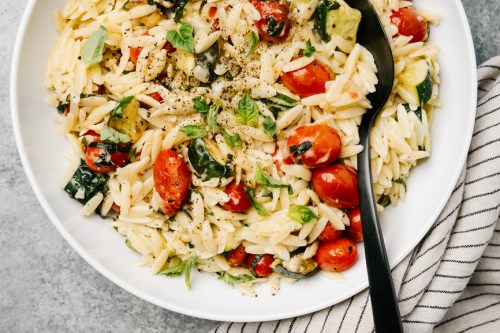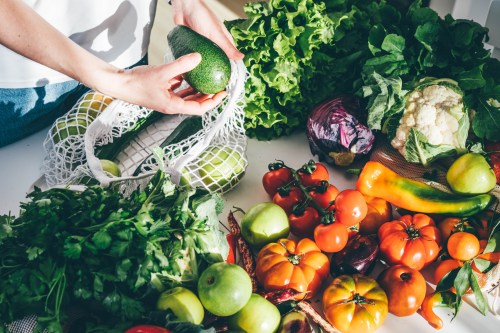Our editors independently select these products. Making a purchase through our links may earn Well+Good a commission
5 Ways To Use Leftover Soup Without Getting (Ahem) Soup-er Sick of It
Discover leftover soup ideas to help you turn the dish into a quick, tasty, and inexpensive exciting new meal.

Being able to make foods in batches can be a clutch, time-saving mealtime hack. But by the time day three or four hits, chances are you may not be as thrilled to eat (yet again) what you prepped in advance. Meal fatigue is real, my friends. That’s when it’s time to get a little creative with your leftovers.
Experts in This Article
Denise Bustard, PhD, is the scientist-turned-food blogger behind Sweet Peas & Saffron.
culinary consultant, chef, and the author of SOUPified: Soups Inspired by Your Favorite Dishes
It’s a cooking fact that some leftovers are easier to transform than others. Leftover pizza, for example, is still going to be leftover pizza, no matter how you try to rework those slices. Soup, on the other hand, is a chameleon. It’s one reason why healthy food blogger, Liz Moody, recommends making some at the beginning of the week to stash in the fridge to repurpose for the days to come.
Not convinced soup can be the multitasking ingredient you want it to be? Rounded up here are five handy leftover soup ideas to keep in your metaphorical apron pocket for when you need them. Not only will they keep your meals interesting, but they help reduce food waste, too. A win-win.
5 leftover soup ideas to beat mealtime fatigue
1. Use it as cooking liquid for rice or quinoa
Sweet Peas & Saffron food blogger Denise Bustard likes to use leftover soup to give neutral-tasting grains, like rice and quinoa, more flavor. Think of it like a carton of chicken or veggie stock packed with even more flavor. “Using leftover soup not only infuses the rice or quinoa with added flavor, but also bulks it up with vegetables and protein—assuming the soup includes these items—making it a complete meal,” Bustard says. Even though it only takes about five minutes to combine the grains and soup, it instantly makes it a lot more interesting than having either one separately.
2. Use it to make pasta sauce
Michele Di Pietro is so passionate about soup that she wrote a whole book about it, SOUPified: Soups Inspired by Your Favorite Dishes. As you can imagine, leftover soup is something she encounters on a regular basis, especially when making a big ol’ batch of slow cooker chicken soup. One way she says she likes to reuse her soup is to make pasta sauce. “Simmer three to four cups of the leftover soup in a skillet until the liquid has been reduced by about 25 percent. While the leftover soup is simmering, [separately] cook your favorite long pasta, ideally a thicker cut such as tagliatelle, fettuccine, pappardelle, or bucatini,” she suggests.
Once the pasta is cooked, drain it, then add it to the reduced soup mixture and let simmer together briefly before adding olive oil and a sprinkle of cheese for a finishing touch. The end result is a pasta dinner with a sauce that’s much more interesting than just jarred tomato sauce. In our experience, this works best when paired with heartier, blender soups. Think a thick and creamy roasted red pepper, curried butternut squash soups, or our favorite three-ingredient soup, cauliflower soup. The idea is that the thicker the sauce, the more easily it’ll be absorbed by the cooked pasta.
3. Use it to make one-pot pasta
Similarly to Di Pietro, Bustard likes combining leftover soup with pasta for a quick and easy dinner. “In most cases, pasta cooks in stock with seasonings, vegetables, proteins, and other ingredients, absorbing so much flavor as it cooks. Swapping out stock for leftover soup could accomplish the same, adding new vegetables, proteins, and flavors to your one-pot pasta recipe,” she says.
Plus, not only can you get dinner on the table using one pot (or baking dish), you can do so completely hands-free. Take Feel Good Foodie’s baked spaghetti dinner for inspiration. To make it, you’ll add uncooked pasta along with spices in the bottom of a baking dish. Then, stir in the veggies (or the leftover roasted vegetables) of your choice (onions, bell pepper, garlic), water, and marinara, before baking it in the oven covered with foil until the pasta is tender and the veggies are cooked. However, instead of using store-bought marinara and freshly-chopped veggies, it’s the perfect time to make use of your leftover soup that has all of these components already in the mix. Anti-inflammatory tomato soup is our recommendation.
4. Add it to make a casserole creamier or thicker
Casserole and soup are essentially the superheroes of comforting meals, especially come the cold winter months. So, why not combine ’em together? In perfect better-together fashion, Bustard likes to use leftover soup as the liquid-y base of a hearty casserole recipe or to make delicious vegetarian casserole recipes. “An idea to use up creamy or thicker soups could be to play around with turning them into a casserole. Whenever a casserole calls for liquid, consider using the soup instead,” Bustard says.
For example, Bustard recommends swapping out the enchilada sauce in this Mexican spaghetti squash casserole recipe with a creamy soup. Not only does this help add depth of flavor, but also takes the nutrient density up a notch. The only drawback? Not all soups will work best for this version of leftover soup recipes. “Just be careful if any casseroles specifically require thin liquid, as swapping that for thick, creamy soup may not work,” she adds, as one caveat. That said, you can always learn how to thicken soup to turn any liquidy kinds into the appropriate consistency in mere seconds.
5. Turn creamy soup leftovers into a dipping sauce
So, can you turn soup into sauce? You sure can. When Di Pietro has a hearty, creamy leftover soup she wants to reuse in a new way, she says she’ll often whirl it into a delicious dip. To do this, simmer your leftover soup on the skillet, then sprinkle on cheese to thicken the texture. Then, bake it in the oven at 400°F until it’s bubbly and golden. “Serve it with baguette slices, crackers, or tortilla chips,” she says. Not a cheese lover? You can also thicken your soup by throwing it in the blender with a handful of cauliflower. Since cauliflower has a neutral taste, it will add bulk without changing the flavor.
How long can leftover soup be held for?
Since soups are typically made with both protein and veggies, it’s bound to help you cover your nutrient bases in a way that’s quicker than cooking your protein, vegetables, and other components of your meal separately. Soup can definitely be as interesting on day four as it was on day one—all it takes is a little creativity. That said, it’s important to ensure food safety comes first, and that leftover soup is kept fresh and safe to eat for as long as possible. So, how long are leftovers good for? Let’t dig into it.
According to the U.S. Department of Agriculture (USDA), there are several steps you can take to ensure your leftovers are correctly handled to ensure food safety, minimizing the risk of contracting a foodborne illness. For starters, proteins should be cooked to the appropriate temperature (for context, poultry should be cooked to an internal temperature of 165°F as measured with a food thermometer). Not only does food need to be cooked to the appropriate temperature, it should also be kept out of the “temperature danger zone,” aka temperatures between 40°F and 140°F, where bacteria can grow rapidly.
This is particularly important when handling leftovers. As a rule of thumb, the USDA says leftovers must be refrigerated within two hours of being removed from a heat source. Perishable foods that have been left in room temperature for more than two hours should be disposed of. In turn, to prevent bacterial growth at all costs, it’s important to cool leftovers as quickly as possible and store it at 40ºF or below. The USDA states: “a big pot of soup, for example, will take a long time to cool, inviting bacteria to multiply and increasing the danger of foodborne illness. Instead, divide the pot of soup into smaller containers so it will cool quickly.”
Finally, keep in mind that the USDA suggests keeping leftovers in the refrigerator for no more than three to four days or frozen for up to three to four months to ensure freshness and safety. Check out our tips and tricks for how to freeze soup safely and efficiently.
On the hunt for a good soup recipe? See how to make vegan Italian meatball soup in the video below:
Sign Up for Our Daily Newsletter
Get all the latest in wellness, trends, food, fitness, beauty, and more delivered right to your inbox.
Got it, you've been added to our email list.










